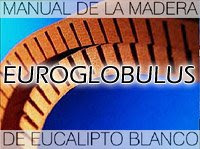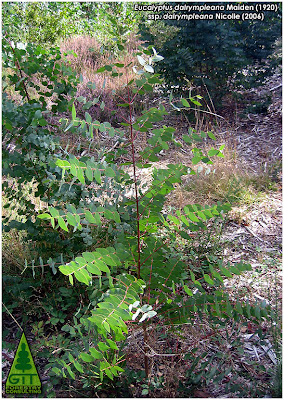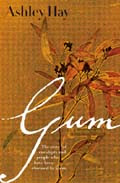Eucalyptus dalrympleana in Galicia (NW Spain) ... and elsewhere
Gustavo Iglesias Trabado 
GIT Forestry Consulting - Consultoría y Servicios de Ingeniería Agroforestal - www.git-forestry.com

GIT Forestry Consulting - Consultoría y Servicios de Ingeniería Agroforestal - www.git-forestry.com
Dalrymple who?
Back in 1767 a British gentleman named Alexander Dalrymple theorised on the existence of a Terra Australis Incognita to the south of New Guinea, and suggested a route to the Unknown based on the old maps done by Luis Váez de Torres, the Spaniard that a century earlier could have discovered Terra Australis... twice. Three years after the theory Sir Joseph Banks was onboard Captain Cook's Endeavour towards Botany Bay, which would start the practical discovery of Australian flora and soon of a new country for the British Empire. Eucalyptus country.
 Fig 1: Mountain Gum grove in the Highlands of Galicia (NW Spain)
Fig 1: Mountain Gum grove in the Highlands of Galicia (NW Spain)A species distributed accross a large spatial range in Australia, E. dalrympleana was not described until 1920, when Joseph Maiden (later honoured with E. globulus ssp. maidenii) gave that name to samples collected by forester Wilfred De Beuzeville (honoured later also with E. pauciflora ssp. debeuzevillei) in New South Wales and Victoria.
The eucalypt of Richard Dalrymple-Hay, Chief Commissioner of Forests in NSW some 150 years after the first Dalrymple, can become a giant single stemmed tree 50 m height but is generally grown in short rotation cycles in European plantations than what is needed for such a size, achieving normally 20 to 30 m by harvest time.
E. dalrympleana: four subspecies
Given its presence in a large geographic area, from Southern Queensland and the Tablelands of New South Wales to Tasmania, variability is inevitable. Currently our eucalypt botanist of reference, Dean Nicolle, recognises four subspecies:
- E. dalrympleana ssp. dalrympleana - Mainly present along the Great Dividing Range in both Victoria and Southern NSW
- E. dalrympleana ssp. heptantha - 7 flowered mountain white gum from Northern NSW
- E. dalrympleana ssp. 'Tasmania' - In mid to high elevations in the Highlands of the Central Plateau
- E. dalrympleana ssp. 'Alpine' - Small to medium sized tree growing in restricted populations found above 1200 m altitude in the Victorian Alps
 Fig 2: Smooth white bark with grey patches in Eucalyptus dalrympleana, also known as Mountain White Gum
Fig 2: Smooth white bark with grey patches in Eucalyptus dalrympleana, also known as Mountain White GumBy the days of Maiden describing new species, another eucalypt, E. viminalis, was already commonly cultivated in South Africa, South America, California and Europe. Also known as white gum and manna gum, it can be easily confused with E. dalrympleana, as can also happen with E. rubida.
This opens a door for more confusion, since seed of white gum grown overseas until well beyond 1920 could have been of any of these species, but only E. viminalis was known. Which can easily make local races derived from old trees before foresters understood the importance of good seed collection methods and good seed provenance records also suspicious of having some Mountain Gum blood in them.
This opens a door for more confusion, since seed of white gum grown overseas until well beyond 1920 could have been of any of these species, but only E. viminalis was known. Which can easily make local races derived from old trees before foresters understood the importance of good seed collection methods and good seed provenance records also suspicious of having some Mountain Gum blood in them.
E. dalrympleana: hybrids and clines
Indeed hybridism is relatively common event in the natural habitat of the White Mountain Gum, and the example of Eucalyptus viminalis x dalrympleana has been found with relative frequency in those areas where both species grow together (which is not so rare, given the high degree of overlapping habitats for both eucalypts, also both within Subgenus Symphyomyrtus and Series Viminales, close relatives).
This was initially suggested to explain variation among seed provenances from mainland Australia by Mendonza as early as 1968, since a narrow 50 m belt of intermediate forms where populations of both species occupy the same habitat later was found. It was later confirmed in forestry trials in Argentina.
A further milestone was established in 1980 by Philips & Reid, who examined a transect of 120 km from sea level to the Highlands in Tasmania and observeed clinal variation in this natural Eucalyptus vimdal Complex, identifying a continuum of intermediate forms from thin lanceolate juvenile leaves of E. viminalis in coastal areas to cordate juvenile leaves typical of E. dalrympleana in the Central Plateau and concluding intermediate specimens were the most common type. Variation for flower buds and seed capsules in what regards to their sizes and numbers was not as consistent as juvenile foliage variation in a geographic sense.
E. dalrympleana: botanical identification
Following our normal recommended methodology to identify Eucalyptus species, after observing the trees as a whole and paying attention to their growth habit and bark type, and having examined samples of flower buds and seed capsules that can lead us on the track of the White Gums, the key factor that can yield more information on what particular subspecies or potential hybrid form under scrutiny we are in front of is, for this particular case, juvenile foliage.
 Fig. 5: Detail of juvenile leaves in E. dalrympleana, rounded to heart shaped, dull green with blueish tone, not waxy. Key ID factor to avoid confusions with other species.
Fig. 5: Detail of juvenile leaves in E. dalrympleana, rounded to heart shaped, dull green with blueish tone, not waxy. Key ID factor to avoid confusions with other species.

This can confirm the prepared observer if a clear case of any subspecies of E. dalrympleana or any subspecies of E. viminalis is present, or if something else. Unless your trees have something to do with France!
 Fig. 5: Detail of juvenile leaves in E. dalrympleana, rounded to heart shaped, dull green with blueish tone, not waxy. Key ID factor to avoid confusions with other species.
Fig. 5: Detail of juvenile leaves in E. dalrympleana, rounded to heart shaped, dull green with blueish tone, not waxy. Key ID factor to avoid confusions with other species.
Fig. 6: Detail of juvenile leaves in E. viminalis, opposite and lanceolate, glossy green, not waxy. Key ID factor to avoid confusions with other species.
This can confirm the prepared observer if a clear case of any subspecies of E. dalrympleana or any subspecies of E. viminalis is present, or if something else. Unless your trees have something to do with France!
E. dalrympleana: French cold hardy eucalypt hybrids
E. dalrympleana is an interesting eucalypt species from the point of view of cold hardiness. As early as 1954 French authorities started trialling different types of eucalypts in the Southern part of the country with aims to timber production. A good range of well identified seed provenances was used for this. Time would prove the extreme frost events occurring every some years in Southern France would take their toll on any wide scale plantation programme, and research on cold hardy Eucalyptus selection, breeding and propagation to obtain select strains would be the logical next step.
This involved several species from the 1972 on, but the focus was centered on two of them, E. gunnii, the Cider Gum from Tasmania, able to cope with absolute minima in the range of -15 to -20ºC, and E. dalrympleana, the Mountain White Gum, that proved itself worthy after evaluation of trials for growth rates and form.
The results of this effort of breeding, selection, domestication and controlled hybridisation yielded in the 1980's a new gene pool with echoes to the natural E. vimdal: Eucalyptus gunnii x dalrympleana, the E. gundal. Frost tolerant in the range of -10 to -15ºC, select clones of this hybrid strain can yield 20 to 25 m3 of timber per hectare and year, which makes it an interesting safe option for the colder part of ATL1 zones, albeit a bit risky for timber production ventures in ATL2 zones except in their milder part. Comparable to some extent in this sense to other cold hardy eucalypts commonly grown for timber production in Northwestern Spain, as E. macarthurii and E. nitens.
After the devastating effects of unusual heavy frosts as the ones affecting the Midi-Pyrénées in 1985, reaching absolute minima lower than -20ºC, the focus has been put on further selection of cold hardy strains among the E. gunnii side of the genetic pool (more than 600 clones) and further planting has taken place in the last 10 years.
The results of this effort of breeding, selection, domestication and controlled hybridisation yielded in the 1980's a new gene pool with echoes to the natural E. vimdal: Eucalyptus gunnii x dalrympleana, the E. gundal. Frost tolerant in the range of -10 to -15ºC, select clones of this hybrid strain can yield 20 to 25 m3 of timber per hectare and year, which makes it an interesting safe option for the colder part of ATL1 zones, albeit a bit risky for timber production ventures in ATL2 zones except in their milder part. Comparable to some extent in this sense to other cold hardy eucalypts commonly grown for timber production in Northwestern Spain, as E. macarthurii and E. nitens.
After the devastating effects of unusual heavy frosts as the ones affecting the Midi-Pyrénées in 1985, reaching absolute minima lower than -20ºC, the focus has been put on further selection of cold hardy strains among the E. gunnii side of the genetic pool (more than 600 clones) and further planting has taken place in the last 10 years.
E. dalrympleana: the Spanish case
In Northeastern Spain, efforts for the development of plantings based on E. dalrympleana in Catalonia that had started in the late 1970's were rocketing during the 1980-1990 decade, and varietal selection plus clonal propagation was attempted with some success in the early 1990's. Some 3000 ha of both E. dalrympleana and E. gunnii existed in Girona back then, and specimens of some provenances resisted temperatures down to -17ºC.
 Fig. 7: Timber plantation of cold hardy E. dalrympleana at 600 m elevation in the highlands of Galicia ready for harvest.
Fig. 7: Timber plantation of cold hardy E. dalrympleana at 600 m elevation in the highlands of Galicia ready for harvest.In Northwestern Spain, small groves of E. dalrympleana, E. viminalis, intermediate forms between them, and some E. gunnii exist scattered in Central Galicia, evolving unwatched into local races at altitudes varying from 500 to 900 m accross the tablelands and some mountain ranges. We always keep an eye on plus trees. You never know what open pollination can yield.
Mendonza, L. A. (1968) Morphological characters and cold resistance in some natural Eucalyptus hybrids. M. Sc. Thesis, Australian National University.
Mendonza, L. A. (1974) Ensayos de procedencias de Eucalyptus camaldulensis Dehn, y E. viminalis Labill. en el norte de la provincia de Buenos Aires. IDIA Suplemento Forestal 1973-74, 53-60.
Philips, R. L. & Reid, J. B. (1980) Clinal variation between Eucalyptus viminalis Labill. and E. dalrympleana Maiden. Australian Journal of Botany 28, 329-342.
Marien, J.N. & Thibout, H. (1982) Les Eucalyptus en France. Annales de Recherches Sylvicoles 1981, AFOCEL, Association Forêt-Cellulose, 34 – 72
Griffin, A. R., Burguess, I. P., & Wolf, L. (1988) Patterns of natural and manipulated hybridisation in the genus Eucalyptus L'Hérit. - a review. Australian Journal of Botany 36, 41-66.
Ruíz, J. (1993) Selection and vegetative propagation of Eucalyptus dalrympleana Maiden. Proceedings of IUFRO-AFOCEL meeting: Mass Production Technology for Genetically Improved Fast Growing Forest Tree Species. Bordeaux 14-18/september/1992. Vol II pp: 277-283
Mendonza, L. A. (1974) Ensayos de procedencias de Eucalyptus camaldulensis Dehn, y E. viminalis Labill. en el norte de la provincia de Buenos Aires. IDIA Suplemento Forestal 1973-74, 53-60.
Philips, R. L. & Reid, J. B. (1980) Clinal variation between Eucalyptus viminalis Labill. and E. dalrympleana Maiden. Australian Journal of Botany 28, 329-342.
Marien, J.N. & Thibout, H. (1982) Les Eucalyptus en France. Annales de Recherches Sylvicoles 1981, AFOCEL, Association Forêt-Cellulose, 34 – 72
Griffin, A. R., Burguess, I. P., & Wolf, L. (1988) Patterns of natural and manipulated hybridisation in the genus Eucalyptus L'Hérit. - a review. Australian Journal of Botany 36, 41-66.
Ruíz, J. (1993) Selection and vegetative propagation of Eucalyptus dalrympleana Maiden. Proceedings of IUFRO-AFOCEL meeting: Mass Production Technology for Genetically Improved Fast Growing Forest Tree Species. Bordeaux 14-18/september/1992. Vol II pp: 277-283
Rodríguez, S. & Ruíz, J. (1993) Progreso con eucaliptos resistentes al frío en Cataluña. Actas del I Congreso Forestal Español. Sociedad Española de Ciencias Forestales - SECF. Pontevedra, 14-18/Junio/1993. Vol. II pp: 47-52
Nguyen, The N. (2003) Présentation générale de l'Eucalyptus. Lettre d'information semestrielle Eucalyptus. Fiche Nº1. AFOCEL, Association Forêt Cellulose. [PDF]
Melun, F. & Nguyen, The N. (2005) Fiches Clonales: Eucalyptus gundal (E. gunnii x dalrympleana). AFOCEL, Association Forêt Cellulose. [PDF]
Purse, J. (2005) Eucalyptus species with potential for biomass in the British Isles. PrimaBio, Eucalyptus Specialists.
Nicolle, D. (2006) Eucalyptus of Victoria and Tasmania. Bloomings Books. Melbourne.
An intrepid plantsman photographs what is possibly the northernmost flowering Eucalyptus in the world. A blooming E. dalrympleana... in the fjords of Norway!
 Northernmost flowering Eucalyptus: E. dalrympleana at 61ºN
Northernmost flowering Eucalyptus: E. dalrympleana at 61ºN
Recommended book
We started at Dalrymple and jumped to Dalrymple-Hay talking about eucalypts today, so the proper thing is jumping now from Dalrymple-Hay to Hay to end up this Eucalyptus story. By Gum!
Nguyen, The N. (2003) Présentation générale de l'Eucalyptus. Lettre d'information semestrielle Eucalyptus. Fiche Nº1. AFOCEL, Association Forêt Cellulose. [PDF]
Melun, F. & Nguyen, The N. (2005) Fiches Clonales: Eucalyptus gundal (E. gunnii x dalrympleana). AFOCEL, Association Forêt Cellulose. [PDF]
Purse, J. (2005) Eucalyptus species with potential for biomass in the British Isles. PrimaBio, Eucalyptus Specialists.
Nicolle, D. (2006) Eucalyptus of Victoria and Tasmania. Bloomings Books. Melbourne.
Curious links
An intrepid plantsman photographs what is possibly the northernmost flowering Eucalyptus in the world. A blooming E. dalrympleana... in the fjords of Norway!
 Northernmost flowering Eucalyptus: E. dalrympleana at 61ºN
Northernmost flowering Eucalyptus: E. dalrympleana at 61ºNRecommended book
We started at Dalrymple and jumped to Dalrymple-Hay talking about eucalypts today, so the proper thing is jumping now from Dalrymple-Hay to Hay to end up this Eucalyptus story. By Gum!
by Ashley Hay
Subscribe to receive EUCALYPTOLOGICS via RSS
© 2007-2008 Gustavo Iglesias Trabado. Please contact us if you want to use all or part of this text and photography elsewhere. We like to share, but we do not like rudeness.































0 Comments by our readers :::
Send a comment to EUCALYPTOLOGICS